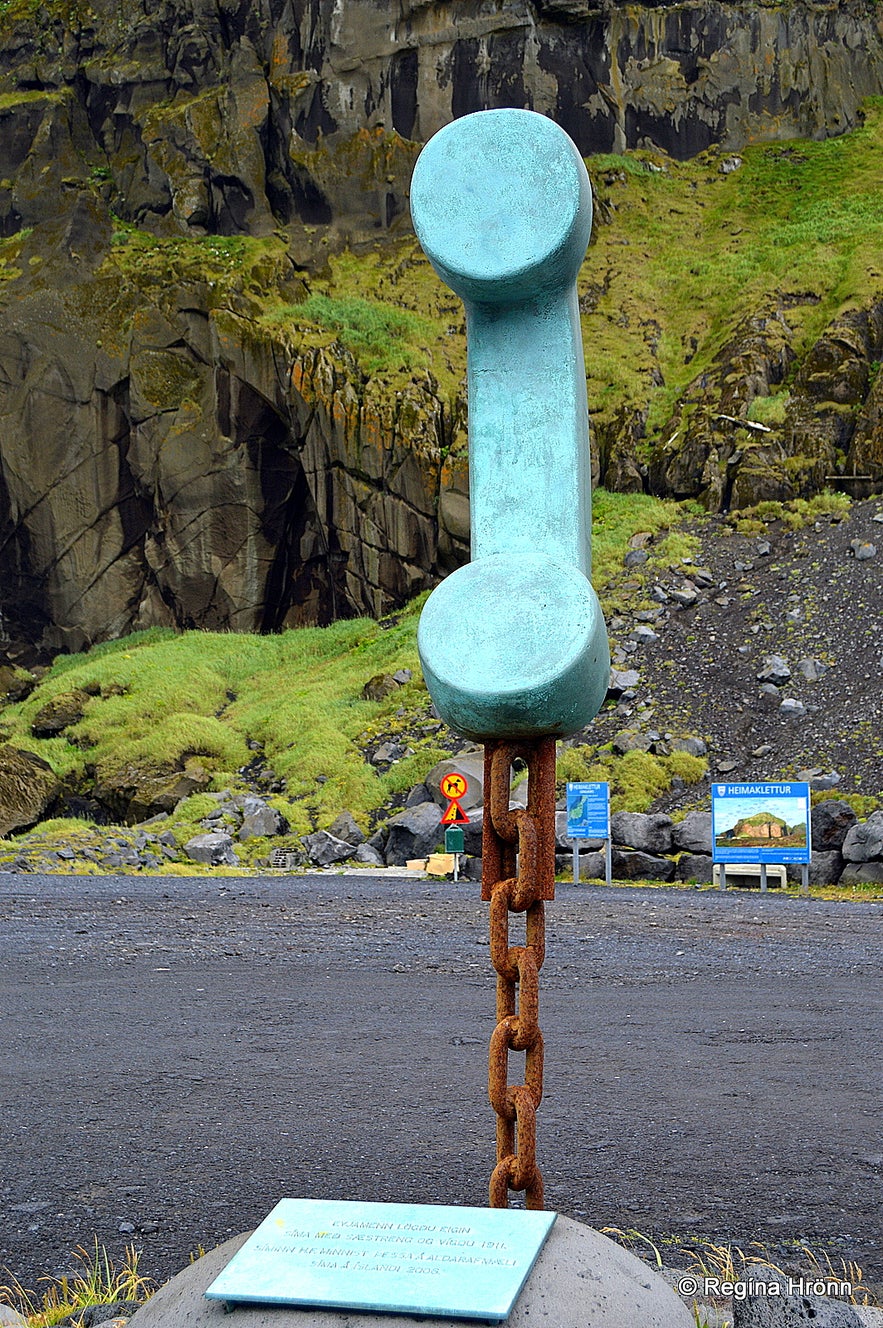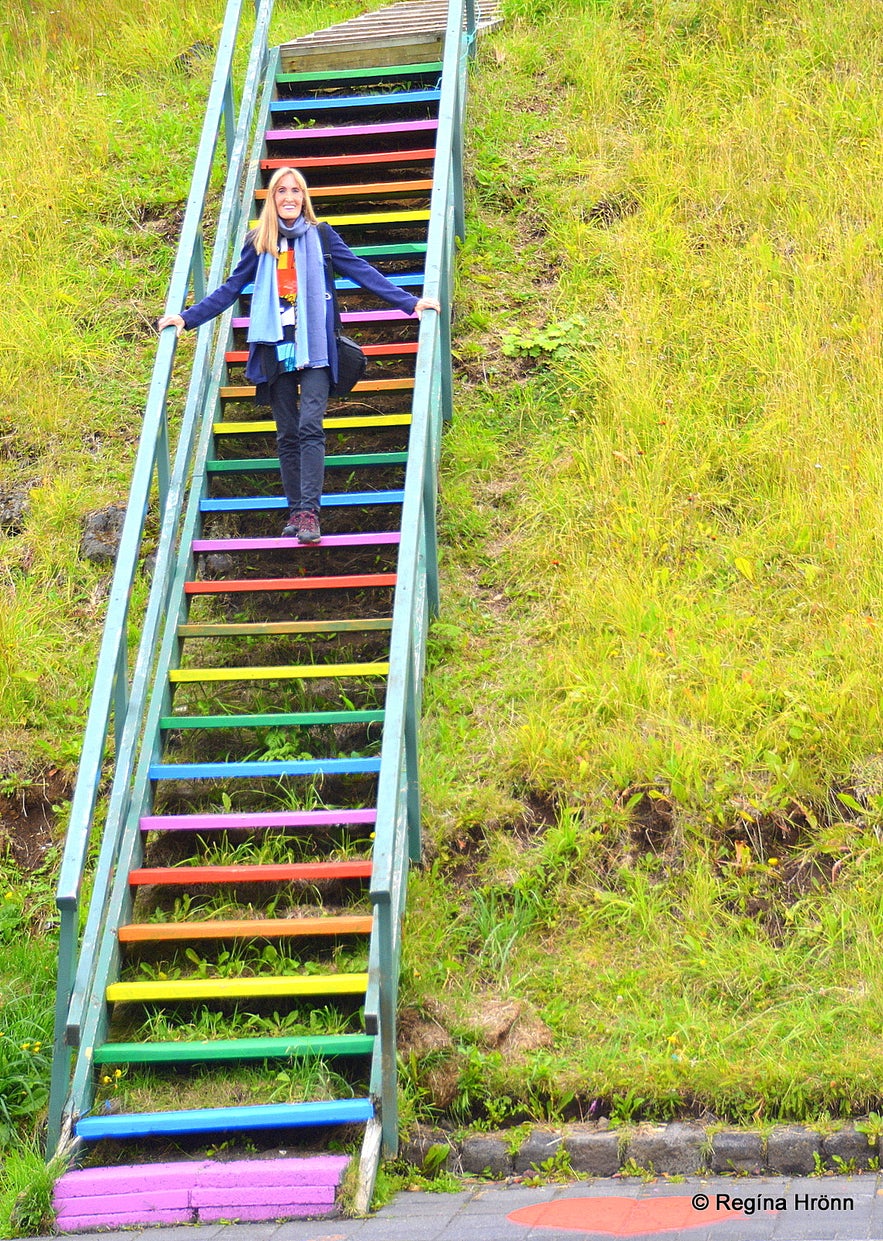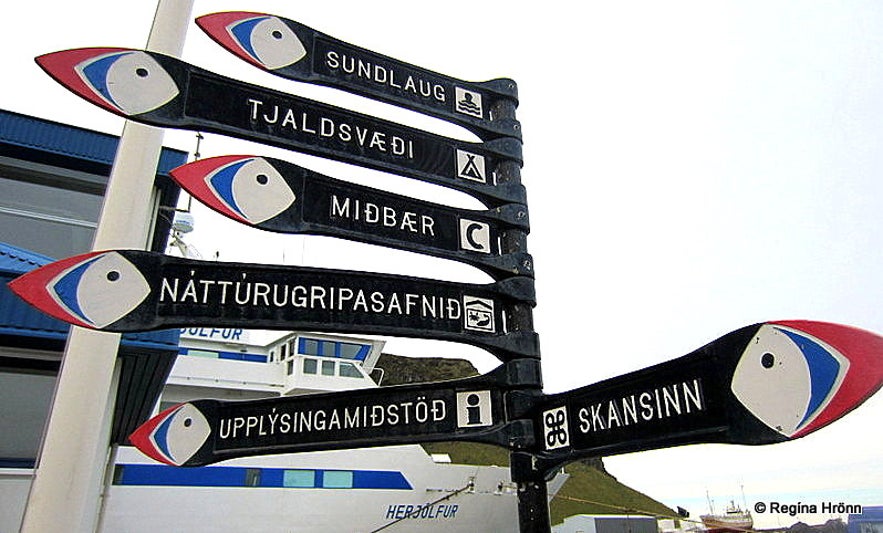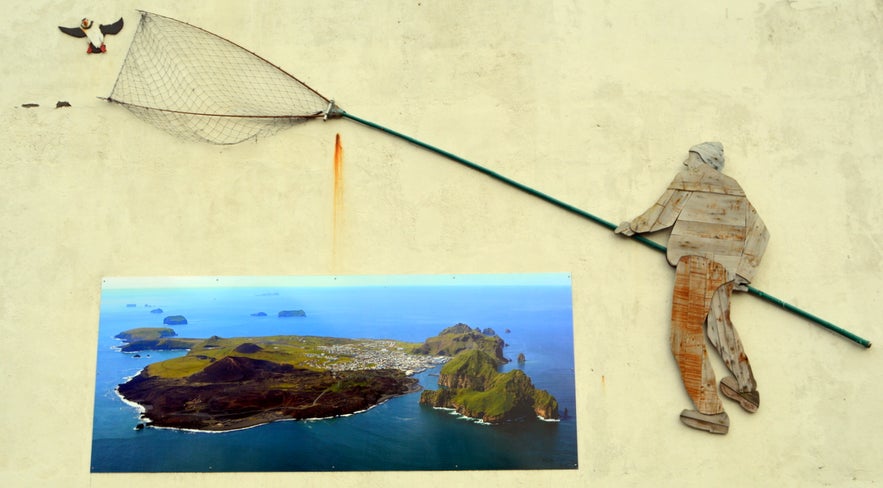
The Westman Islands - the Settler, the Stave Church, and more interesting Things to see


In a previous travel-blog, I told you about Kötlutangi pit, the southernmost point of the mainland of Iceland. The Westman Islands are even more south than Kötlutangi; the volcanic island is the southernmost point of Iceland.
Top photo: Heimaklettur and the Westman Islands harbour
 The electric ferry Herjólfur sails to the Westman Islands
The electric ferry Herjólfur sails to the Westman Islands
Remember why these islands got the name Vestmannaeyjar - the Westman Islands?
I told you that story in my travel-blog about Hjörleifshöfði promontory: the Blood Brothers Ingólfur and Hjörleifur.
Hjörleifur, the blood-brother of our first settler, Ingólfur Arnarson, had Irish slaves. The slaves killed Hjörleifur in 875 after they had only stayed for half a year in Iceland, and fled to the Westman Islands.
Top photo: Heimaklettur rock
Ingólfur Arnarson and his wife Hallveig at the Saga Museum in Reykjavík
Ingólfur chased the Irish slaves to the Westman Islands and killed them. They were called Vestmenn and thus the Westman Islands - Vestmannaeyjar got their name.
To reach the Westman Islands you either have a choice of catching the ferry, Herjólfur, or flying.
I have visited the Westman Islands many times and we always drive to Landeyjahöfn harbour in South Iceland and take the ferry in the morning. 
Mt. Helgafell
Sometimes we stay overnight or leave the islands again in the evening.
I would advise you to stay overnight and experience these beautiful islands to the fullest and learn about their history and the volcanic eruption which started in the middle of the night in 1973 in the backyard of the Islanders' home.
Mt. Helgafell volcano in my photo above is named after Helgi the Irish slave who was killed there.
Visiting the Beluga whale sisters in the Sea Life Trust and Beluga Sanctuary
The Westman Islands have very interesting museums and tours, so do not miss experiencing most of this volcanic island during your Iceland visit.
The Westman Islands are a volcanic archipelago of some 15 islands south of the mainland of Iceland. The only inhabited island is the biggest island called Heimaey Island.
It is 13.4 km2 and around 4,414 people live there. The main industry is fishing and now tourism.

Heimaey - the lava from the volcanic eruption
In 1973 a volcanic eruption started on Heimaey island. I have written a special travel-blog on the volcanic eruption and my hike up to the rim of the Eldfell volcano.
The volcanic eruption lasted from the 23rd of January until the 3rd of July.
It is the only volcanic eruption to start in a town in Iceland and the inhabitants had to be evacuated immediately and transported to the mainland of Iceland.
At the Eldheimar museum
The Islanders had to leave their houses and belongings and hundreds of houses got buried under lava and cinders.
All in all more than 400 houses got buried under the cinders or damaged by the volcanic eruption, and in some areas, the Islanders' houses got buried under 3-10 meters of cinders and pumice!
Some of these houses have been excavated and you can see one of them at the Eldheimar - the Pompei of the North Museum.
 Eldheimar museum - the Pompei of the Northe
Eldheimar museum - the Pompei of the Northe
At the Eldheimar museum - the Pompei of the North, you can learn all about the volcanic eruption in 1973 and Surtsey island, which was created in a volcanic eruption in 1963-1967.
My photo above of the eruption in Heimaey is on display at the Eldheimar museum.
Herjólfsbærinn - Herjólfur's farmstead
Herjólfsbærinn - Herjólfur's farmstead
When you visit Herjólfsdalur valley you will notice something that looks like an old turf farm.
It is a replica of a hypothetical farmstead, and here some of the oldest human habitation signs in Iceland might have been found.
The hypothetical farm was built in 2006 in Herfjólfsdalur valley. The building material of the hypothetical farm, the longhouse, and the outhouses, is rocks, timber, and turf.
 Inside Herjólfsbærinn turf farm before it became a museum
Inside Herjólfsbærinn turf farm before it became a museum
Herjólfsdalur valley is better known nowadays as the main party place at the time of Verslunarmannahelgin - the first weekend in August, which is a long weekend - then Icelanders flock to Herjólfsdalur valley and celebrate Þjóðhátíð í Eyjum in the Westman Islands.
This tradition started in the year 1874 when we celebrated the millennium of the Settlement of Iceland and the fact that we got our first constitution from the Danish King Christian IX.

Herjólfsbærinn - Herjólfur's farmstead - my husband having fun with one of the Vikings
In the spring of 2023, a Viking exhibition was opened inside Herjólfsbærinn. I love this change, now Herjólfsbærinn has become alive with sounds and colourful characters from Viking history.
The family who runs Eyjatours is now the manager of the museum at Herjólfsbær.
I contacted Einar (Ebbi) and had a conversation with him about this new Viking museum and his future plans for expanding the museum.
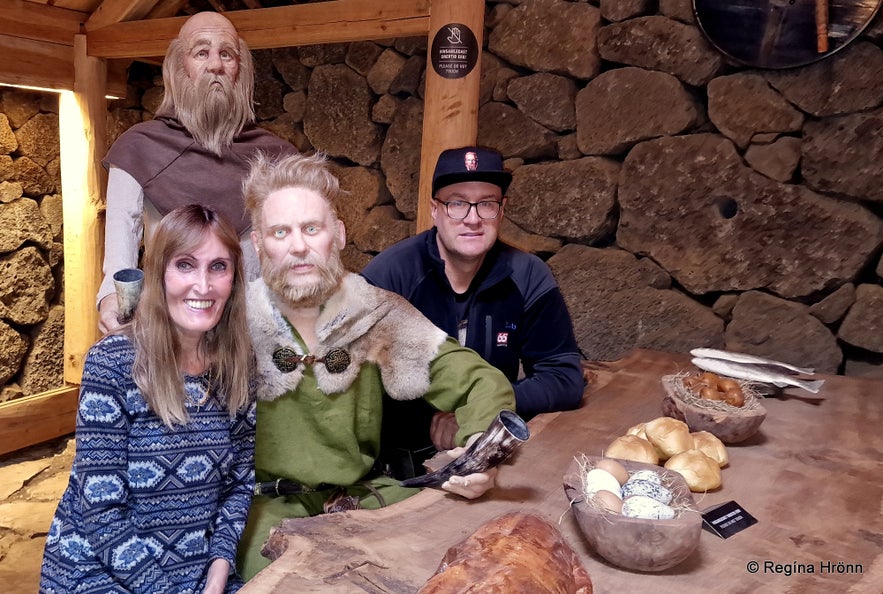 With some of the Vikings at the museum and Ebbi
With some of the Vikings at the museum and Ebbi
As those of you, who read my travel-blogs know, then I love Viking museums and Viking activities and have written a long travel-blog about everything Viking in my country.
Remember my travel-blog about one of the tours of Eyjatours which I joined several years ago and Einar (Ebbi) was the guide: The Westman Islands in Iceland - the Puffin and Volcano Tour - Local Guidance
The Stave Church
The stave church
One of the most beautiful buildings in the Westman Islands is the replica of the old stave church. It has got such a magical touch.
The stave church was built in the Westman Islands just before the adoption of Christianity in the year 1000.
The Norwegian king Olav Tryggvason sent his Icelandic agents, Hjalti Skeggjason and Gissur hvíti - the white, to Iceland to try to convert the Vikings from paganism to Christianity.

The stave church
He ordered Hjalti and Gissur to build a church in the location where they would first come ashore.
They stayed in the Westman islands for 2 days and built the stave church and named it Klemensarkirkja church, but St. Klemens was the patron saint of seafarers.
They were on their way to the parliament Alþingi at Þingvellir, so this church was built a little bit earlier than the conversion to Christianity was accepted in Iceland later that summer.

Inside the stave church
This church was donated to the congregation of the Westman Islands, so might it have been the first parish church in Iceland?
The beautiful stave church we see today is a national gift from the Norwegian government. It was presented to us Icelanders and consecrated on the 30th of July in the year 2000 in celebration of the millennium of Christianity in Iceland. What a lovely gift :)
 The Stave church and beautiful work of art at Skansinn
The Stave church and beautiful work of art at Skansinn
Norwegian carpenters built the stave church in Holtalen style, which was popular in Norway around the year 1000.
The Norwegian king, Harald, and his queen Sonja attended the consecration of the church.
The church is quite different on the inside, it is panelled and bright. The altarpiece is an exact reproduction of the oldest altarpiece in a Norwegian stave church in Norway.

The stave church
Above the stave church, you will find the first maternity hospital in Iceland from 1849 in an old black house called Landlyst.
Virkið - The Fortress
The Fortress
In the vicinity of the stave church is the Fortress, which was built in 1586, when Iceland was under the reign of the Danish king and the Danish had a monopoly on trading with Iceland.
The Danish king had a fortress built in the Westman Islands as protection from the English traders and fishing operators, who often did not respect any restrictions and boundaries.
Well, much, later on, there were also Cod Wars between the Icelanders and the English, but that is another story.
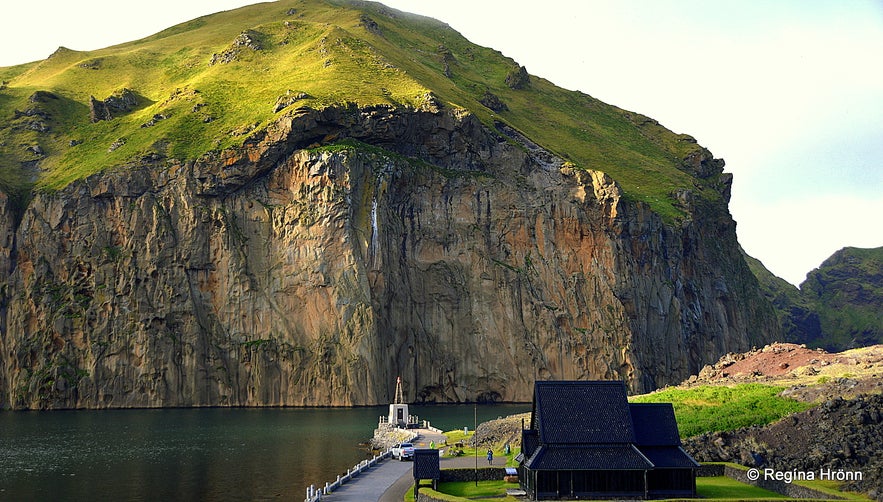
The stave church and Heimaklettur rock
The Fortress also protected the island from pirates. In Tyrkjaránið or the Turkish raid on the 16th of July in 1627 around 300 pirates landed in Pirate Cove in the Westman Islands to shun the manned cannons at the Fortress.
The Algerian (not Turkish as they were thought to be) pirates were looking for slaves and they captured some 242 Icelanders and killed 36, but back then the population of the Westman islands was only around 500 people.
Around 300 pirates hunted the poor people down and sold them into slavery in Algeria.
While visiting the peaceful Westman islands today it is difficult to imagine the horror and chaos this pirate attack caused back then.
While walking around the island I tried to put myself in the footsteps of these poor Icelanders, but it broke my heart thinking about this horrific act.
Slavery is so awful and it makes me sad thinking about the fact that it still exists in the world today :(
 The memorial for Hetjur hafsins - the Heroes of the Sea at Skansinn
The memorial for Hetjur hafsins - the Heroes of the Sea at Skansinn
After this horrible raid, the Fortress was improved.
In the mid-19th century a regiment was established in the Westman islands and military drills took place here at the Fortress on Skansinn.
During WW2 the base camps of the English soldiers were located at Skansinn.

My husband fooling around on the Fortress ;)
The Fortress walls were rebuilt in 1991-1992 and the cannon was a gift from Ísfélag Vestmannaeyja in 1997. It is only used on special occasions. Skansinn is a protected area.
After the volcanic eruption in 1973 on Heimaey Island, this area changed and you can see the lava in my photo above.
The lava, fortunately, stopped by the wall of the skerries on Hringskersgarður, but it was feared that the lava might close the channel.
Ræningjatangi - Pirate Cove
In my photo above you will see the cove Ræningjatangi or Pirate Cove where the pirates landed to shun the canons at the Fortress.
Here the Algerian pirates came ashore in the Turkish Raid on the 17th of July 1627.
They were thought to be Turks and thus the name, which is still used for this dreadful act of piracy on the Islanders.
The information sign by Ræningjatangi
At the time of the raid, some 500 people lived in the Westman Islands. It is hard to imagine what the few people left must have felt like after 242 islanders had been taken away and 36 killed.
220 people hid from the pirates, many of them hiding in caves in the Westman Islands. Close to Herjólfsdalur valley, there is a hidden cave called Hundraðmannahellir, or the Cave of the Hundred.
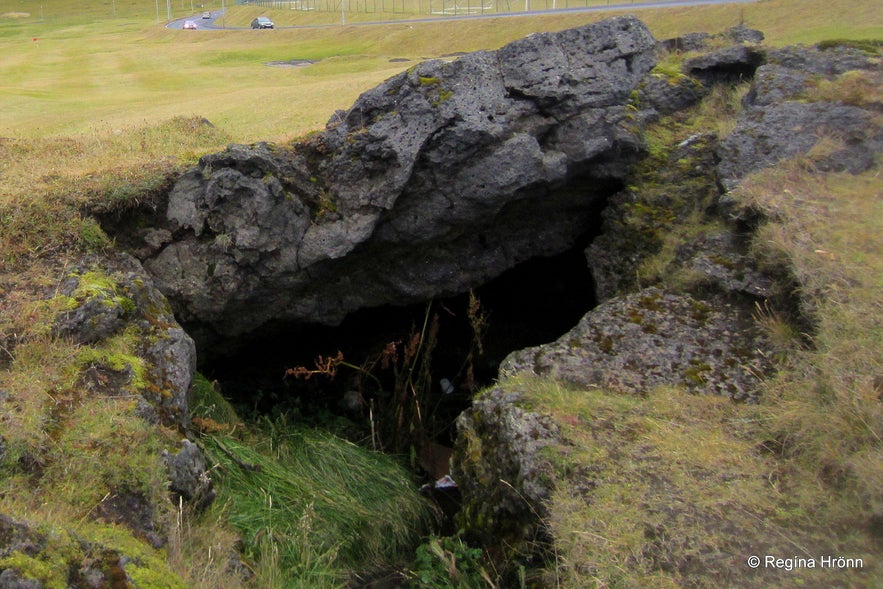 Hundraðmannahellir cave
Hundraðmannahellir cave
It is a cave where almost a hundred people hid from the pirates during the Turkish Raid back in 1627.
The pirates found the people, who were hiding in this cave, as one of them had brought their dog with them and it was spotted by the pirates. These unfortunate people were captured and sold into slavery in Algeria.
 The information sign by Hundraðmannahellir cave
The information sign by Hundraðmannahellir cave
I visited the cave and looked down into it and thought it was too small for a hundred people - but it has sagged and got filled with sand through the centuries.
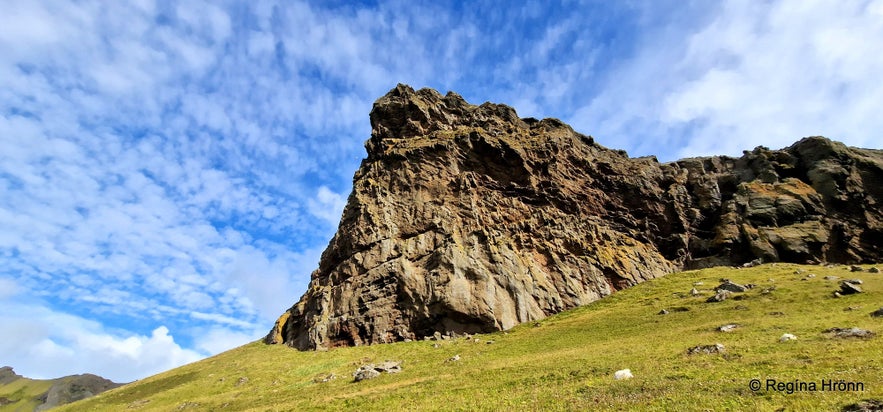 Háin
Háin
In Háin rocks you will notice some stacked fish caves if you look closely.
When the Algerians raided the Westman Islands back in 1627, women and children were hoisted down into the caves.
The pirates climbed to reach the poor people and shot the ones they didn't reach.
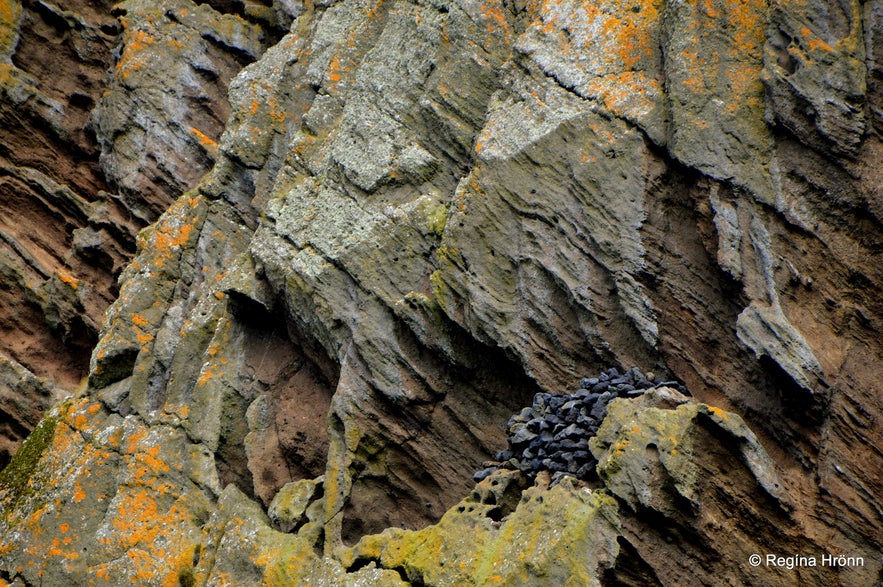 Fish caves in Háin rock
Fish caves in Háin rock
The story goes that in the skirt of one of the women who survived, who was hiding in the Þorlaugargerðishilla, there were 18 bullet holes.
Stórhöfði cape - is this the windiest place in Europe?
Blowing away on Stórhöfði cape
Stórhöfði cape is the southernmost part of Heimaey Island, the largest island on Westman Islands, and the only inhabited island in the archipelago.
Only the "new" island Surtsey lies more south, some 20 km southwest of Heimaey island, and can be seen from Stórhöfði cape. Surtsey Island was created by a volcanic eruption from 1963-1967 and is now on the UNESCO World Heritage list.

The view from Stórhöfði cape in the dusk
Like Surtsey, the Stórhöfði cape was created in a volcanic eruption in the ocean some 6,000 years ago.
The cape is 22 meters high and it is the windiest place in Iceland. And it is believed to be the windiest place in Europe!
The photo above is of the view from Stórhöfði cape with Surtsey hidden somewhere in the distance behind the island on the photo. Surtsey is the southernmost part of the Westman Islands and thus the southernmost part of Iceland.

The weather station at Stórhöfði cape
There is much more wind here than ever in Vestmannaeyjarbær town, so when we see the weather forecast for Iceland it sometimes looks like the Westman islands are blowing away, but that is because they measure the wind at Stórhöfði, and not in town.
When I visited it in September 2013 it was so windy that I could barely stand on my feet. My husband and I barely made it up the hill in this strong wind and were afraid of being blown off into the sea!
My husband is a sturdy man, but in the end, I was the one helping him up the hill fighting against the strong wind :)

The weather station and view-dial at Stórhöfði
There has been a weather station at Stórhöfði cape since 1921 and the fastest wind speed in the Northern Hemisphere has been measured here on the cape.
When we visited Stórhöfði on the Puffin and volcano tour in 2016 it was so foggy that we couldn't visit the cape as there was absolutely no visibility.
We went there by ourselves later on when the fog had lifted and took some photos.

The view-dial at Stórhöfði cape
There is a beautiful view from Stórhöfði of the islands and one can even spot Surtsey somewhere from here.
You will find a view-dial at Stórhöfði, where you will find the names of all the islands and mountains, which can be seen from Stórhöfði.
 The view-dial at Stórhöfði
The view-dial at Stórhöfði
Park your car in the parking lot by Stórhöfði, but from there is an easy, short walk to the cape. The problem is just standing on one's feet and not being blown away.
Of course, it is not always windy at Stórhöfði, but it happens often.
The Big Handset
The big phone receiver
You will see a statue of a big phone receiver in the Westman Islands by Heimaklettur rock. It looks like it is hanging in thin air.
Written in Icelandic by this statue is: "Eyjamenn lögðu eigin síma með sæstreng og vígðu 1911. Síminn h.f. minnist þessa á aldarafmæli síma á Íslandi 2006". Do you need a translation?
The people living in the Westman Islands are called Eyjamenn or the Islanders. This term is only used for the people living on this particular island.

My mother-in-law and I by the big phone receiver
So in English, this means: "The islanders on the Westman islands laid their own submarine cable and thus got a phone. It was inaugurated in 1911. The phone company Síminn h.f. commemorates this act on the 100th anniversary of the phone in Iceland in 2006".
The phone receiver was put up here in 2006, on the 100th anniversary of phones in Iceland.
I just love statues like this one and one can take some fun photos here, f.ex. like the one above of my mother-in-law holding the receiver up to my ear ;)
The rainbow stairs
The rainbow stairs
In the summer of 2020, I invited my mother for a 2-night stay in the Westman Islands. We stayed at Guesthouse Hóll in an old but very beautiful house.
At the end of our street, Miðstræti, I saw the rainbow stairs.
I am a sucker for rainbow locations, so I asked my mother to take my photo with the stairs :) We also have a rainbow street in the Westman Islands.

Guesthouse Hóll Miðstræti 5a
I search for rainbow locations in Iceland and we have many rainbow streets in Iceland, one in Reykjavík, one in Seyðisfjörður in East Iceland, another one in Ólafsvík and we have a rainbow pavement in Skagaströnd f.ex.
The rainbow stairs are located on the corner of Miðstræti and Kirkjuvegur.
Murals, street decorations & artwork
 A beautiful mural in the Westman Islands
A beautiful mural in the Westman Islands
Heimaey Island is beautifully decorated with murals and artwork of all kinds.
Apart from the amazing nature and history of the Westman Islands, it is a pure delight just walking around admiring the beautiful works of art and murals that can be found in so many places on the island.
The street signs in Heimaey Island are so cute and funny, with puffins leading the way :)
Information signs downtown
I love stuff like this, creative, welcoming, and friendly stuff. Kudos to Eyjamenn (the Islanders) for decorating their town in such a lovely manner.
You will find streets which are painted with white and multi-coloured fish and lovely colourful murals in so many places.

Colourful trash bins
And I noticed that all the trash bins are beautifully painted as well.
I must have taken photos of 10 different trash bins with brightly painted artwork - this is so cute and adds colour and life to the town :)
 One of the brightly painted trash bins in the Westman Islands
One of the brightly painted trash bins in the Westman Islands
But there is much more and I hope you like learning about the artwork on the islands as much as I like looking for it :)
Everywhere you look there is either amazing nature or beautiful work of art. What a lovely town this is.
Beautiful artwork in the Westman islands
The mural above I found when I was walking by the harbour - it is so colourful and depicts the town on Heimaey Island.
I noticed that it was painted in 2003 - exactly 30 years after the volcanic eruption in 1973 in Eldfell.
The artwork below depicts an islander catching a puffin - yes, some of the puffins are eaten, they are cute, I know, but the Islanders have to make use of the resources they have on the island.
Artwork in the Westman islands
Have you watched the video of when a puffin bit Gordon Ramsay's nose when he was puffin hunting in the Westman islands?
In the video, you can watch how puffins are hunted and how one gets its revenge.
So don't mess with the cute puffin - it knows how to defend itself!
I love the work of the Australian graffiti artist Guido Van Helten and I found one of his beautiful paintings on Heimaey Island.
Guido paints faces of people across the walls of houses and buildings - and his work is so detailed and so life-like that it takes my breath away every time I see new artwork by Guido.
We have several walls painted by Guido in Reykjavík, one of his artworks in Akureyri, and two in Skagaströnd in North Iceland.

Artwork by Guido van Helten
Guido paints the faces of people, using old photos of people, who are connected to the building or house in question.
In Reykjavík, there is one painting of an old man who used to live in that particular house.
The work by Guido in Heimaey Island shows the local girl, Halla Svavarsdóttir. To quote Guido: "The use of old images has become a recurrent theme in my work, through the nostalgia and the sentiment community attach to photographs, old stories, and people".
And he does an excellent job! Be on the lookout for his work when you visit Iceland.

Beautiful artwork in the Westman islands all lit up by the sun
There is artwork all over Heimaey in different locations. We had brought our car with us on the ferry and while we were driving around I had to stop the car in so many places so that I could get out and enjoy the artwork and take pictures :)
Like this lovely painting on a building down by the harbour. I don't know who the artist is, but I absolutely love it! It is so much more serene and friendly looking at this painting of a child playing as opposed to just looking at the white wall of this building.

Artwork by Einar Jónsson in the Westman islands
If you walk around town you will find many more statues and works of art, and I found two prominent pieces of artwork, which are very familiar to me.
The beautiful artwork in my photo above is by Einar Jónsson, who is my all-time favourite Icelandic sculptor and whose museum you will find next to one of the landmarks of Reykjavík - the Hallgrímskirkja church.

Artwork by Ásmundur Sveinsson in the Westman islands
There is another great artwork close by - the big Giantess (Tröllskessan) by the noted Ásmundur Sveinsson, sculptor, whose museum you will also find in my hometown of Reykjavík.
Ásmundur Sveinsson had a totally different style from Einar Jónsson as you can see if you compare these two statues.
 Artwork in the Westman Islands
Artwork in the Westman Islands
I love the idea of decorating the town like this. There are many more pieces of artwork than the ones I have added here, it is just a pure delight for art lovers to visit Heimaey Island.
The Memorial of drowned fishermen
The Memorial of drowned fishermen
The Westman Islands are an archipelago where the main industry is fishing. The Islanders have lost way too many of their inhabitants to the cruel ocean.
From 1901 until 1951, when the Memorial of drowned fishermen was unveiled, some 232 fishermen drowned by the Westman islands. Back in 1900, only some 500 people lived on the islands.

The Memorial of drowned fishermen
During the volcanic eruption the Islanders, who had had to flee to the mainland, were given permission to visit the Westman islands in order to honour their drowned fishermen through this monument.
That was in June and the volcanic eruption officially stopped on July 3rd, 1973.
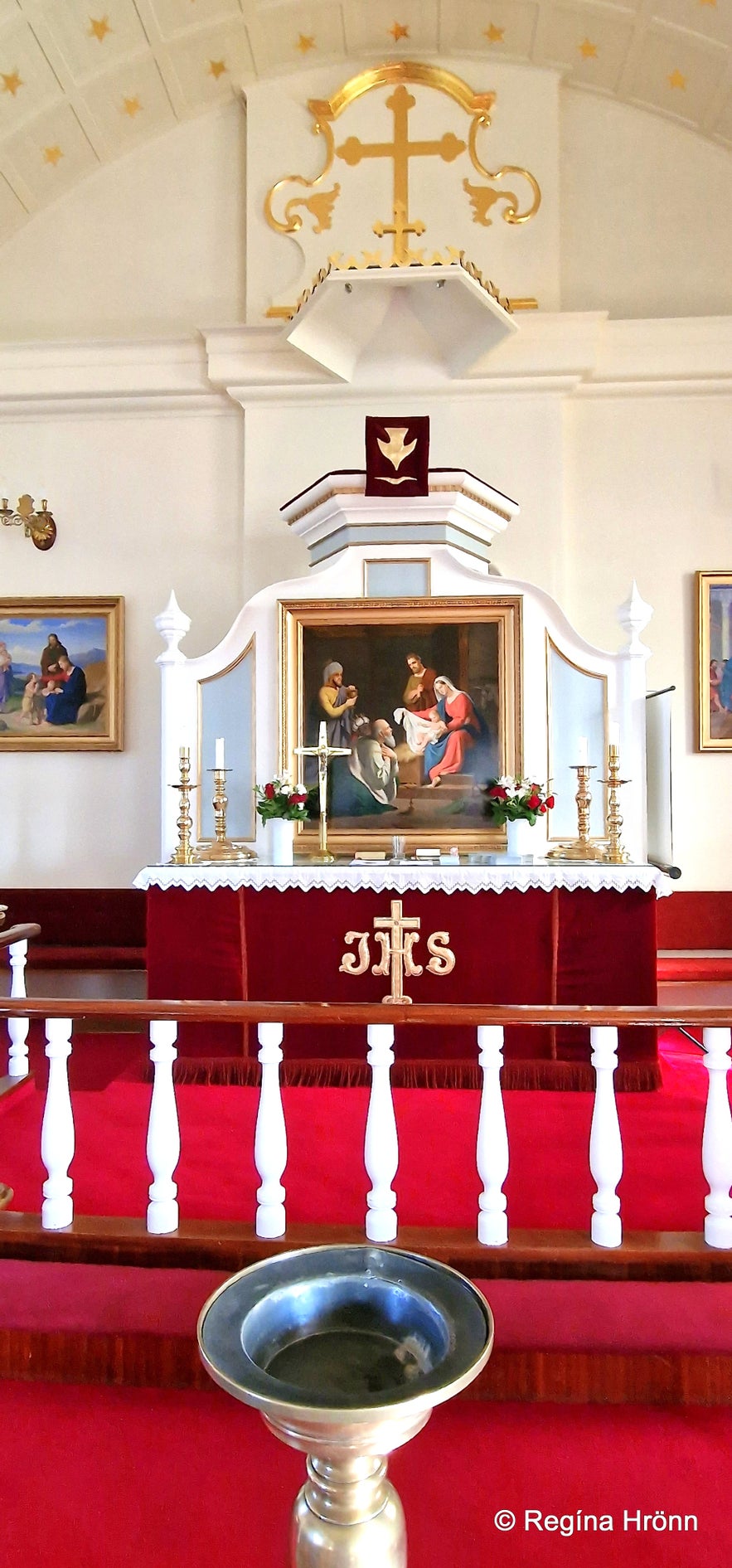 Inside Landakirkja church
Inside Landakirkja church
Landakirkja church is the 3rd oldest stone church in Iceland, built in 1774-1780. It has been renovated and altered through the centuries.
It is quite large and very beautiful inside with a myriad of golden stars on a white ceiling.
It is usually kept locked but during my last visit to the Westman Islands in the fall of 2023 the minister was doing some work inside the church and allowed us to come inside and take some photos.
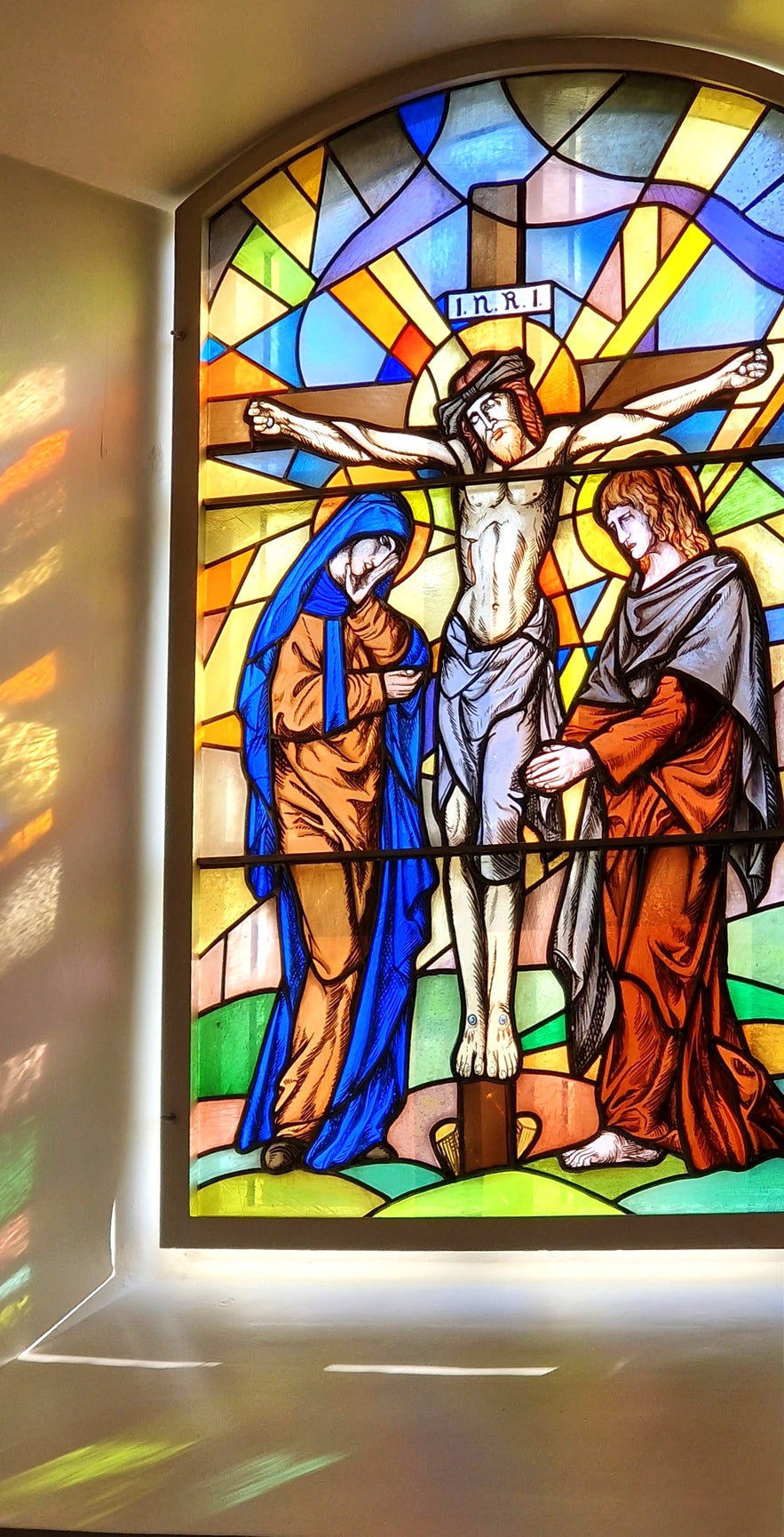 Stained glass windows in Landakirkja church
Stained glass windows in Landakirkja church
In my next travel-blog on the Westman islands, I am going to tell you about the Eldfell volcano and Eldheimar - the Pompei of the north and my hike on Mt. Eldfell - the Mountain of Fire - the volcano which spewed out lava and cinder in 1973 on the town of Westman islands.
The 4 other travel-blogs I have written on the Westman Islands are:
Westman Islands - Sæheimar - Have you ever met a Puffin up Close and Personal?
Westman Islands - the Puffin and Volcano Tour - Local Guidance
Herjólfsbærinn - Herjólfur's Old Farmstead in the Westman Islands
 On top of Mt. Eldfell
On top of Mt. Eldfell
If you want to visit the Westman Islands you can rent a car in Reykjavík and drive yourself to Landeyjahöfn in South Iceland and take the ferry Herjólfur over to the islands.
Here is the location of the Westman Islands on Google Maps.
Have a lovely time in the beautiful Westman Islands :)
บล็อกอื่นที่น่าสนใจ
คุยเฟื่องเรื่องแสงเหนือหรือออโรร่า Aurora!!
แสง Aurora ที่ใครหลายคนต่างฝันอยากจะได้มีโอกาสชื่นชมมหัศจรรย์แห่งความงามของมันสักครั้งแสงสีเขียว สีแดง สีม่วง สีชมพู ที่เกิดจากอนุภาคของปะจุไฟฟ้าทำปฏิกิริยากับธาตุต่างๆอทิอะตอมออซิเจนหรือธาตุไนโตรเจนกอ่านเพิ่มเที่ยวไอซ์แลนด์ช่วงเดือนไหนดี
ไอซ์แลนด์เป็นประเทศที่ใครๆก็มักจะบอกว่ามาช่วงไหนก็สวย เพราะทุกฤดูที่นี่สวยแปลกแตกต่างกันไปตามแบบเสน่ห์เฉพาะตัวแบบไม่มีใครยอมใคร ทำให้นักท่องเที่ยวที่เคยมาที่นี่ กลับมาเที่ยวอีกครั้งแล้วครั้งเล่า เพรอ่านเพิ่มChasing Waterfalls in Iceland
Iceland is spectacular in so many ways and Icelandic nature is quite unique with its vast landscape, volcanic activity, geothermal areas, glacier lagoons and sceneries, black sand beaches and spectอ่านเพิ่ม

ดาวน์โหลดตลาดการท่องเที่ยวที่ใหญ่ที่สุดของไอซ์แลนด์ลงในโทรศัพท์ของคุณเพื่อจัดการการเดินทางทั้งหมดของคุณได้ในที่เดียว
สแกนรหัส QR นี้ด้วยกล้องในโทรศัพท์ของคุณแล้วกดลิงก์ที่ปรากฏขึ้นเพื่อเพิ่มตลาดการท่องเที่ยวที่ใหญ่ที่สุดของไอซ์แลนด์ไว้ในกระเป๋าของคุณ ป้อนหมายเลขโทรศัพท์หรือที่อยู่อีเมลของคุณเพื่อรับ SMS หรืออีเมลพร้อมลิงก์ดาวน์โหลด








